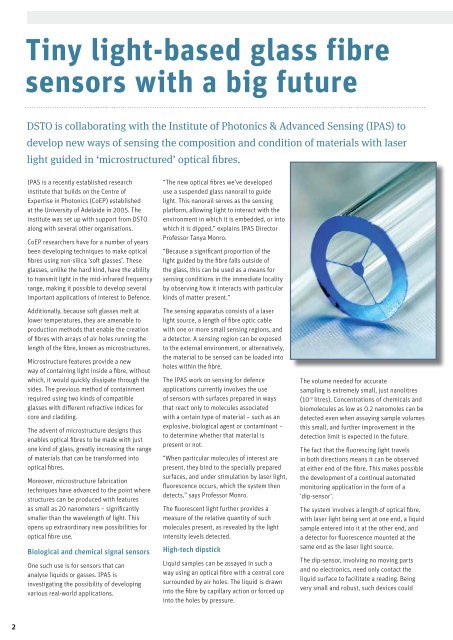DSA Volume 1 Issue 4 December 2010 - Defence Science and ...
DSA Volume 1 Issue 4 December 2010 - Defence Science and ...
DSA Volume 1 Issue 4 December 2010 - Defence Science and ...
You also want an ePaper? Increase the reach of your titles
YUMPU automatically turns print PDFs into web optimized ePapers that Google loves.
Tiny light-based glass fibre<br />
sensors with a big future<br />
DSTO is collaborating with the Institute of Photonics & Advanced Sensing (IPAS) to<br />
develop new ways of sensing the composition <strong>and</strong> condition of materials with laser<br />
light guided in ‘microstructured’ optical fibres.<br />
IPAS is a recently established research<br />
institute that builds on the Centre of<br />
Expertise in Photonics (CoEP) established<br />
at the University of Adelaide in 2005. The<br />
institute was set up with support from DSTO<br />
along with several other organisations.<br />
CoEP researchers have for a number of years<br />
been developing techniques to make optical<br />
fibres using non-silica ‘soft glasses’. These<br />
glasses, unlike the hard kind, have the ability<br />
to transmit light in the mid-infrared frequency<br />
range, making it possible to develop several<br />
important applications of interest to <strong>Defence</strong>.<br />
Additionally, because soft glasses melt at<br />
lower temperatures, they are amenable to<br />
production methods that enable the creation<br />
of fibres with arrays of air holes running the<br />
length of the fibre, known as microstructures.<br />
Microstructure features provide a new<br />
way of containing light inside a fibre, without<br />
which, it would quickly dissipate through the<br />
sides. The previous method of containment<br />
required using two kinds of compatible<br />
glasses with different refractive indices for<br />
core <strong>and</strong> cladding.<br />
The advent of microstructure designs thus<br />
enables optical fibres to be made with just<br />
one kind of glass, greatly increasing the range<br />
of materials that can be transformed into<br />
optical fibres.<br />
Moreover, microstructure fabrication<br />
techniques have advanced to the point where<br />
structures can be produced with features<br />
as small as 20 nanometers – significantly<br />
smaller than the wavelength of light. This<br />
opens up extraordinary new possibilities for<br />
optical fibre use.<br />
Biological <strong>and</strong> chemical signal sensors<br />
One such use is for sensors that can<br />
analyse liquids or gasses. IPAS is<br />
investigating the possibility of developing<br />
various real-world applications.<br />
“The new optical fibres we’ve developed<br />
use a suspended glass nanorail to guide<br />
light. This nanorail serves as the sensing<br />
platform, allowing light to interact with the<br />
environment in which it is embedded, or into<br />
which it is dipped,” explains IPAS Director<br />
Professor Tanya Monro.<br />
“Because a significant proportion of the<br />
light guided by the fibre falls outside of<br />
the glass, this can be used as a means for<br />
sensing conditions in the immediate locality<br />
by observing how it interacts with particular<br />
kinds of matter present.”<br />
The sensing apparatus consists of a laser<br />
light source, a length of fibre optic cable<br />
with one or more small sensing regions, <strong>and</strong><br />
a detector. A sensing region can be exposed<br />
to the external environment, or alternatively,<br />
the material to be sensed can be loaded into<br />
holes within the fibre.<br />
The IPAS work on sensing for defence<br />
applications currently involves the use<br />
of sensors with surfaces prepared in ways<br />
that react only to molecules associated<br />
with a certain type of material – such as an<br />
explosive, biological agent or contaminant –<br />
to determine whether that material is<br />
present or not.<br />
“When particular molecules of interest are<br />
present, they bind to the specially prepared<br />
surfaces, <strong>and</strong> under stimulation by laser light,<br />
fluorescence occurs, which the system then<br />
detects,” says Professor Monro.<br />
The fluorescent light further provides a<br />
measure of the relative quantity of such<br />
molecules present, as revealed by the light<br />
intensity levels detected.<br />
High-tech dipstick<br />
Liquid samples can be assayed in such a<br />
way using an optical fibre with a central core<br />
surrounded by air holes. The liquid is drawn<br />
into the fibre by capillary action or forced up<br />
into the holes by pressure.<br />
The volume needed for accurate<br />
sampling is extremely small, just nanolitres<br />
(10 -9 litres). Concentrations of chemicals <strong>and</strong><br />
biomolecules as low as 0.2 nanomoles can be<br />
detected even when assaying sample volumes<br />
this small, <strong>and</strong> further improvement in the<br />
detection limit is expected in the future.<br />
The fact that the fluorescing light travels<br />
in both directions means it can be observed<br />
at either end of the fibre. This makes possible<br />
the development of a continual automated<br />
monitoring application in the form of a<br />
‘dip-sensor’.<br />
The system involves a length of optical fibre,<br />
with laser light being sent at one end, a liquid<br />
sample entered into it at the other end, <strong>and</strong><br />
a detector for fluorescence mounted at the<br />
same end as the laser light source.<br />
The dip-sensor, involving no moving parts<br />
<strong>and</strong> no electronics, need only contact the<br />
liquid surface to facilitate a reading. Being<br />
very small <strong>and</strong> robust, such devices could<br />
2

















